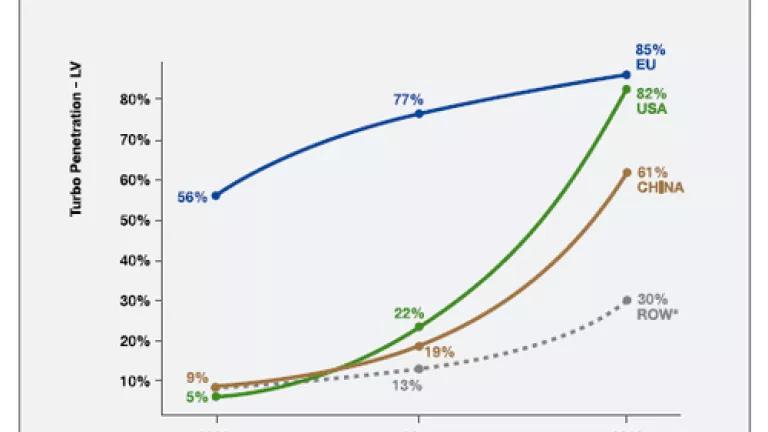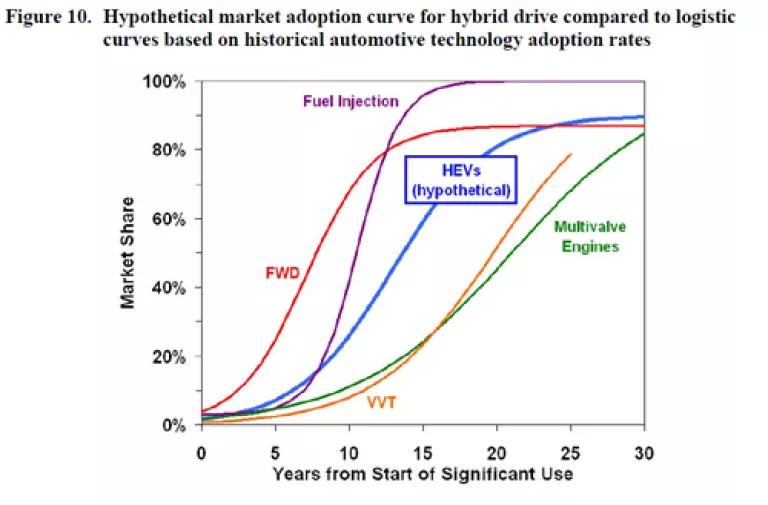
Nothing will pry the hands of true red-blooded Americans from the steering wheels of their V8 pick-up trucks. That’s what automakers have suggested for decades. It doesn’t matter, they said, how much more those gas-guzzling trucks cost to fuel up. Trade in their V8’s for less cylinders with new fangled turbocharger technology? No way.
Surprise. Loyal F150 truck buyers—owners of the most popular pickup in the U.S.—are proving them wrong. April sales stats show the turbocharged V6 3.5-liter version of the F-150, the one equipped with Ford’s fuel-efficient EcoBoost technology, accounted for 36 percent of F-150 sales and 40 percent of orders. With a now razor-thin 13-day supply, the F150 Ecoboost engine factory in Lima, Ohio is running at full tilt.
36 percent is a remarkably high “take rate”, surprising even Ford’s product planners. Ford’s consumer marketing manager Marc Lapine told Automotive News:
"We had a sales forecast, but it has jumped up a little faster than we thought… We thought there would be a little more time between the early adopters and the other people…ready to buy it”
The Ecoboost boasts both more horsepower and more MPG than the outdated V8 it replaces. Its high take rate shows even pickup drivers are not only unafraid of adopting new fuel-efficient technologies; they are also willing to pay more for it.
The Ecoboost has 365 horsepower, 420 pound-feet of torque and a pair of compact turbochargers that eliminate any so-called “turbo-lag.” According to Ford, this package increases F150 fuel economy up to 20 percent and cuts carbon dioxide emissions up to 15 percent compared with comparable V8s while offering more horsepower and more axle-twisting torque—not less. The EcoBoost option price of between $750 to $1,750 apparently is not a deterrent to buyers.
34.1 MPG by 2016 Boosting the Market for Turbos
The Ecoboost F150 example shows that even (and especially) pickup drivers benefit from stronger standards. Congress’s decision in 2007 to boost fuel economy to 35 mpg by 2020 and President Obama’s 2009 decision to boost it even further to 34.1 mpg by 2016 gave automakers like Ford the kick in the pants it needed to fast track the Ecoboost.
Other drivers are benefiting too. In just five years, the number of passenger vehicle models that meet or exceed the 2016 standard of 34.1 mpg has tripled, from 51 to 153.
Importantly, the new “reformed” federal pollution and fuel efficiency standards spur better technology, not smaller cars. Since 2007, these new standards at Detroit’s insistence are based on a “footprint” formula, which requires that all sizes of vehicles get better fuel economy. Bigger vehicles, like pickups meet a less stringent standard; smaller vehicles are held to a higher standard. (High gas prices, of course, are driving a shift to smaller cars.)
With reformed standards and new technologies, better fuel economy can be achieved without making vehicles smaller or less powerful. Stronger standards mean better technology without sacrificing size or performance.
10 Year Adoption Rate for New Automotive Technologies
The Ecoboost example demonstrates how fast automakers can improve fuel efficiency. When motivated, automakers have shown they can fully integrate a significant new technology into the fleet in about 10 years, or two model re-design cycles.
According to data from Wards, the penetration of gasoline and diesel turbocharged engines in 2010 was 5.5 percent. But that is expected to change fast. According to Honeywell and Global Insight, turbocharged equipment cars and light trucks will jump to 22 percent in 2015 and then to 82 percent by 2020, a remarkable four-fold increase every five years (see figure below from Honeywell).
The rapid acceptance and future penetration of the turbocharger mirror experience with other new automotive technologies. Especially when spurred by strong standards, adoption of new technologies can be quite rapid. Spurred by the original fuel economy standards, front wheel drive went from 10 percent in 1978 to 78 percent in 1987. Stronger pollution standards spurred an even faster adoption of fuel injection in the 1990’s.
If the Obama Administration and California set strong pollution and fuel efficiency standards for 2017 to 2025, hybrid technology will be next in line to move into the fast lane. Current market penetration of hybrids is about 2.1 percent. A 62 mpg standard would require about 50 percent penetration of hybrids by 2025, exactly in line with what could be expected based on historical experience, according to one study from the University of Michigan (see figure below from this study).

We are already seeing clear indications this is happening with Japanese, Korean and German automobile manufacturers. The innovative new “Parallel 2 clutch” (P2) hybrids being adopted by the automakers from these countries deliver the same benefits as the most popular systems today but at one-third or less the cost. Furthermore, with its compact size and use of existing transmissions, P2 systems can be rapidly integrated into the fleet.
62 MPG by 2025 Will Make Hybrids the Turbos of Tomorrow
Hopefully, the lesson learned from pick-up truck owners’ adoption of turbocharged V6 engines will be applied by auto industry laggards who believe that the heart of the passenger car market will not adopt hybrid gas-electric cars. Those who believe that we’re forever stuck in our old ways are fond of saying that after 10 years on the market, hybrids are still less than 2.5 percent of the market.
Pick-up truck buyers are showing the way. They demonstrated that they will gladly switch to vehicles with better efficiency—no matter what’s under the hood, as long as it gives them what they want: all the muscle with less fat.
The same holds true for mainstream car buyers. Those who never considered a hybrid, or a clean diesel, or a four-cylinder engine with turbocharging and direct injection, are not only willing to make the switch to higher MPG, that’s what they want to do.
But the auto companies have to build those cars first. And the best way to make sure that automakers build the efficient car that Americans want—vehicles that frankly should have been rolling off production lines years ago—is to establish and enforce feasible slow-and-steady standards for vehicle pollution and efficiency that deliver 62 mpg by 2025.
